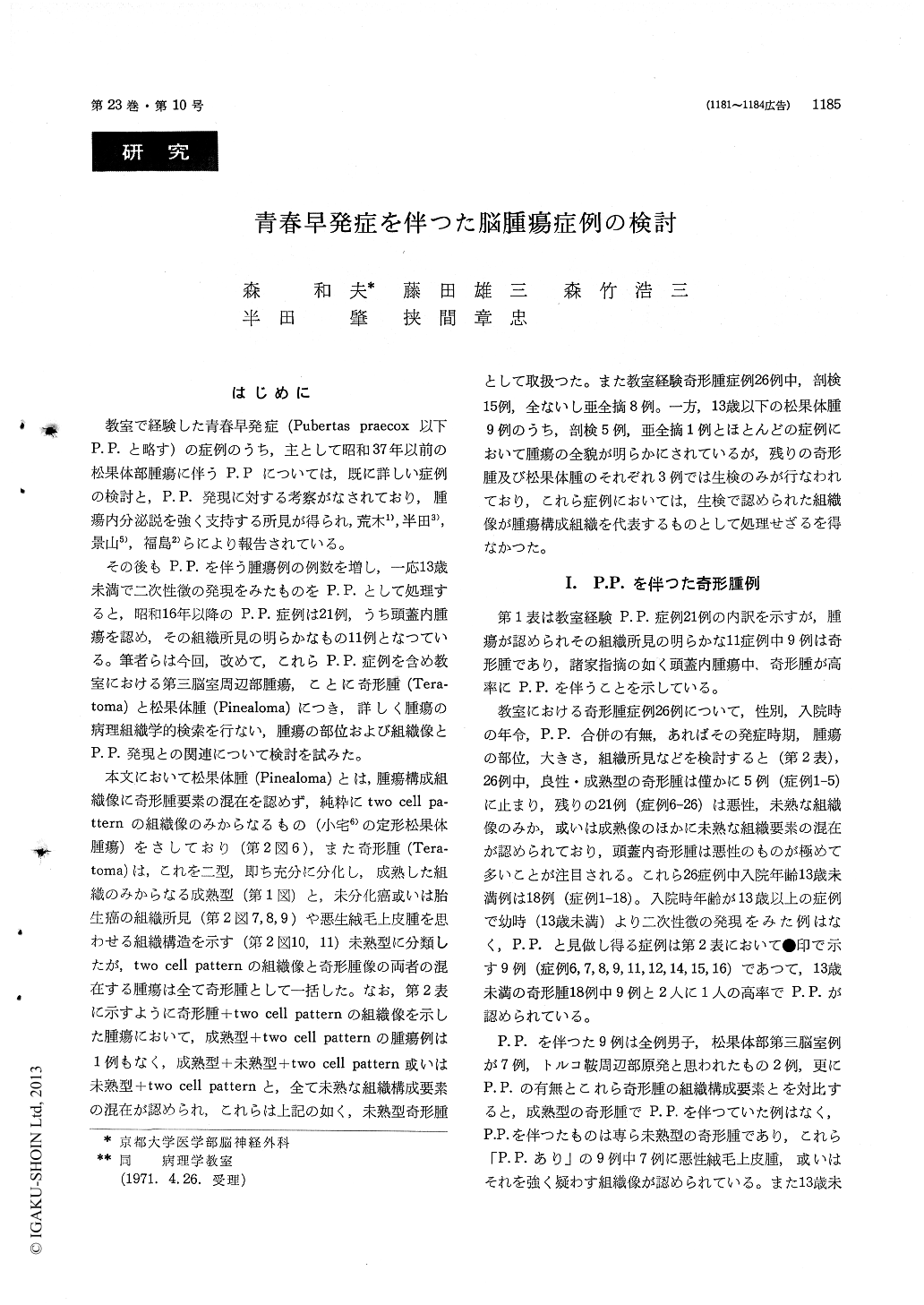Japanese
English
- 有料閲覧
- Abstract 文献概要
- 1ページ目 Look Inside
はじめに
教室で経験した青春早発症(Pubertas praecox以下P.P.と略す)の症例のうち,主として昭和37年以前の松果体部腫瘍に伴うP.Pについては,既に詳しい症例の検討と,P.P.発現に対する考察がなされており,腫瘍内分泌説を強く支持する所見が得られ,荒木1),半田3),景山5),福島2)らにより報告されている。
その後もP.P.を伴う腫瘍例の例数を増し,一応13歳未満で二次性徴の発現をみたものをP.P.として処理すると,昭和16年以降のP.P.症例は21例,うち頭蓋内腫瘍を認め,その組織所見の明らかなもの11例となつている。筆者らは今回,改めて,これらP.P.症例を含め教室における第三脳室周辺部腫瘍,ことに奇形腫(Tera—toma)と松果体腫(Pinealoma)につき,詳しく腫瘍の病理組織学的検索を行ない,腫瘍の部位および組織像とP.P.発現との関連について検討を試みた。
Sexual precocity has been rarely seen in cases with intracranial tumor. In this study, an effort was made to examine nature and location of the mass in our 16 cases with precocity.
In 11 cases out of these 16, nature of tumor was thoroughly examined including 6 cases in which the serial sections of tumor were made.
In 11 histologically verified cases, 6 were teratoma in which 7 were thought to originate from the pineal region and 2 were from the sellar region.
As to the pathological classification of teratoma, authors divided it into two general categories : (1) adult (mature) type, in which tumor was solely made up of well differentiated tissiues and no im-mature element was found and (2) immature type. in which tumor was consisited of an area where anaplastic cell element was found. A tumor com-posed of chorioepithelioma showing both cytotro-phoblast and syncytial trophoblast was included as a variety of the immature type. A tumor contain-ing complex structure of both two cell pattern (Pinealoma) and teratomatous component was treated for teratoma.
In reviewing histologic nature of 26 cases of intracranial teratoma experienced in our clinic (regardless of accompanying the precocity), authors found out that only 5 cases fell into the category of adult type teratoma and 21 cases belonged to the immature type. This indicated that a large number of intracranial teratoma had malignant components in its histologic structures.
Among these 26 cases of teratoma, 9 cases were accompanied with sexual precocity. Histologic patterns of all these 9 cases showed immature type and no case of teratoma with sexual precocity inwhich histology demonstrated benign adult type. Moreover, 7 cases out of 9, contained chorioepi-theliomatous tissue suggesting the possibility of production of the chorionic gonadotropin. Although no effort has been made to prove the presence of gonadotropin from the tumor in these 9 cases, the sexual precocity at least in cases with teratoma would possibly be explained by the ontogenic theory (Askanazy 1906). The pathological nature of tumor was thought to be critical rather than the location where the mass existed.
Besides 9 cases of teratoma, authors experienced 2 cases of precocity with histologically verified mass (a case of pinealoma consisting so called two-cell pattern structure in the sellar region and a case of polar spongioblastoma in the chiasmal region respectively) and also 5 cases with suspected mass in the brain. In these 7 cases, an accidental appearance of prococity without having any direct relation to the mass (or suspected mass), was fully probable. However, all tumors (or suspected tumors) were located around the floor of the third ventricle and it would seem far more likely to assess the direct hypothalamic involvement by the mass (presumably chronic irritable state of the hypothalamus) for the manifestation of precocious puberty.

Copyright © 1971, Igaku-Shoin Ltd. All rights reserved.


